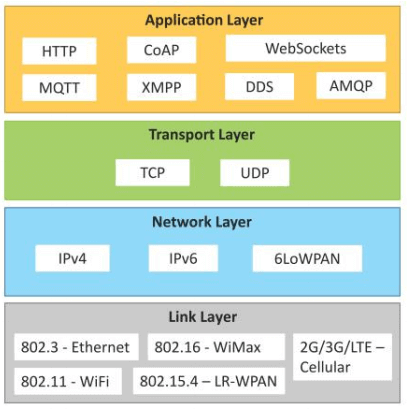Physical Design of IOT (Internet Of Things):
The physical design of an IOT system is referred to as the Things/Devices and protocols that are used to build an IoT system. all these things/Devices are called Node Devices and every device has a unique identity that performs remote sensing, actuating and monitoring work. and the protocols that are used to establish communication between the Node devices and servers over the internet.
• IoT devices can:
• Exchange data with other connected devices and applications (directly or indirectly)
• Collect data from other devices and process the data locally
• Send the data to centralized servers or cloud-based applicationback-endsforprocessing the data
• Perform some tasks locally and other tasks within the IoT infrastructure, based on temporal and space constraints
Tow Point Physical Design(IOT):
Things/Appliance:
Things/Devices are used to build a connection, process data, provide interfaces, provide storage, and provide graphics interfaces in an IoT system. all these generate data in a form that can be analyzed by an analytical system and program to perform operations and used to improve the system.
for example temperature sensor that is used to analyze the temperature generates the data from a location and is then determined by algorithms.
Connectivity:
Appliance like USB hosts and ETHERNET are used for connectivity between the devices/sensor and the server.
Processor:
A processor like a CPU and other units are used to process the data. these data are further used to improve the decision quality of an IoT system.
Audio/Video Interfaces:
An interface like HDMI and RCA devices is used to record audio and videos in a system.
An interface like HDMI and RCA devices is used to record audio and videos in a system.
Input/Output interface:
To give input and output signals to sensors, and actuators we use things like UART, SPI, CAN, etc.
To give input and output signals to sensors, and actuators we use things like UART, SPI, CAN, etc.
Storage Interfaces:
Things like SD, MMC, and SDIO are used to store the data generated from an IoT device.
Other things like DDR and GPU are used to control the activity of an IoT system.
IoT Protocols:
Things like SD, MMC, and SDIO are used to store the data generated from an IoT device.
Other things like DDR and GPU are used to control the activity of an IoT system.
IoT Protocols:
These protocols are used to establish communication between a node device and a server over the internet. it helps to send commands to an IoT device and receive data from an IOT device over the internet. we use different types of protocols that are present on both the server and client-side and these protocols are managed by network layers like application, transport, network, and link layer.
These protocols are used to establish communication between a node device and a server over the internet. it helps to send commands to an IoT device and receive data from an IOT device over the internet. we use different types of protocols that are present on both the server and client-side and these protocols are managed by network layers like application, transport, network, and link layer.
Application Layer protocol:
In this layer, protocols define how the data can be sent over the network with the lower layer protocols using the application interface. these protocols include HTTP, WebSocket, XMPP, MQTT, DDS, and AMQP protocols.
In this layer, protocols define how the data can be sent over the network with the lower layer protocols using the application interface. these protocols include HTTP, WebSocket, XMPP, MQTT, DDS, and AMQP protocols.
Transport Layer:
This layer is used to control the flow of data segments and handle the error control. also, these layer protocols provide end-to-end message transfer capability independent of the underlying network.
This layer is used to control the flow of data segments and handle the error control. also, these layer protocols provide end-to-end message transfer capability independent of the underlying network.
Network Layer:
This layer is used to send datagrams from the source network to the destination network. we use IPv4 and IPv6 protocols as host identification that transfers data in packets.
This layer is used to send datagrams from the source network to the destination network. we use IPv4 and IPv6 protocols as host identification that transfers data in packets.
Link Layer:
Link-layer protocols are used to send data over the network's physical layer. it also determines how the packets are coded and signaled by the devices.
Link-layer protocols are used to send data over the network's physical layer. it also determines how the packets are coded and signaled by the devices.

.jpg)
